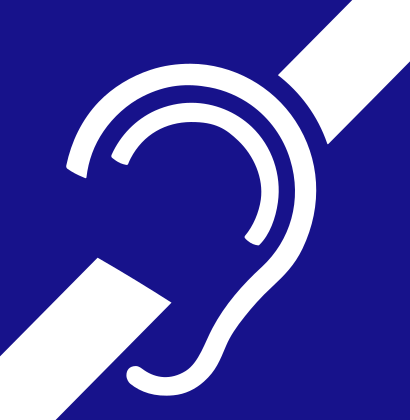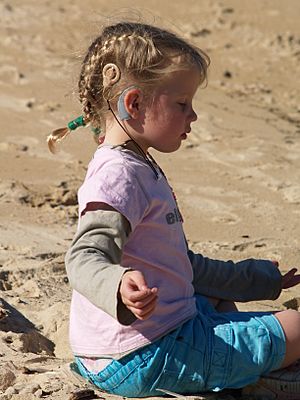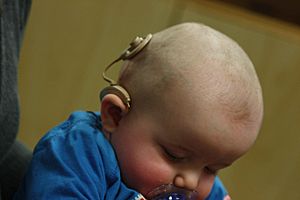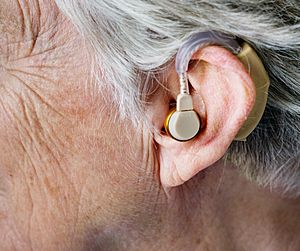Hearing loss facts for kids
Quick facts for kids Hearing loss |
|
|---|---|
| Synonyms | Hearing impaired, Hard of hearing; anakusis or anacusis is total deafness |
 |
|
| The international symbol of deafness and hearing loss | |
| Symptoms | Decreased ability to hear |
| Complications | Social isolation, dementia |
| Types | Conductive, sensorineural, and mixed hearing loss, central auditory dysfunction |
| Causes | Genetics, aging, exposure to noise, some infections, birth complications, trauma to the ear, certain medications or toxins |
| Diagnostic method | Hearing tests |
| Prevention | Immunization, proper care around pregnancy, avoiding loud noise, avoiding certain medications |
| Treatment | Hearing aids, sign language, cochlear implants, subtitles |
| Frequency | 1.33 billion / 18.5% (2015) |
Hearing loss is a partial or total inability to hear. Hearing loss may be present at birth or acquired at any time afterwards. Hearing loss may occur in one or both ears.
In children, hearing problems can affect the ability to learn spoken language, and in adults it can create difficulties with social interaction and at work.
Hearing loss can be temporary or permanent.
Hearing loss related to age usually affects both ears and is due to cochlear hair cell loss.
In some people, particularly older people, hearing loss can result in loneliness.
Deaf people usually have little to no hearing.
Hearing loss may be caused by a number of factors, including: genetics, ageing, exposure to noise, some infections, birth complications, trauma to the ear, and certain medications or toxins. A common condition that results in hearing loss is chronic ear infections. Certain infections during pregnancy, such as rubella, may also cause hearing loss in the child.
Hearing loss is diagnosed when hearing testing finds that a person is unable to hear 25 decibels in at least one ear. Testing for poor hearing is recommended for all newborns.
Hearing loss can be categorized as mild (25 to 40 dB), moderate (41 to 55 dB), moderate-severe (56 to 70 dB), severe (71 to 90 dB), or profound (greater than 90 dB). There are three main types of hearing loss: conductive hearing loss, sensorineural hearing loss, and mixed hearing loss.
About half of hearing loss globally is preventable through public health measures. Such practices include immunization, proper care around pregnancy, avoiding loud noise, and avoiding certain medications.
Early identification and support are particularly important in children. For many, hearing aids, sign language, cochlear implants and subtitles are useful. Lip reading is another useful skill some develop. Access to hearing aids, however, is limited in many areas of the world.
As of 2013 hearing loss affects about 1.1 billion people to some degree.
Contents
Definition
- Hearing loss is defined as diminished ability to hear sounds which would otherwise be heard normally.
- Deafness is defined as a degree of loss such that a person is unable to understand speech, even when the sound is increased. In profound deafness, even the highest intensity sounds may not be detected. In total deafness, no sounds at all.
- Speech perception is another aspect of hearing which is not only the ability to detect sound, but also the ability to understand speech. There are very rare types of hearing loss that affect understanding speech alone.
Use of the terms "hearing impaired", "deaf-mute", or "deaf and dumb" to describe deaf and hard of hearing people is discouraged by many in the deaf community as well as advocacy organizations, as they are offensive to many deaf and hard of hearing people.
Diagnosis
Hearing loss is generally measured by playing generated or recorded sounds, and determining whether the person can hear them. Hearing sensitivity varies according to the frequency of sounds.
Prevention
It is estimated that half of cases of hearing loss are preventable. About 60% of hearing loss in children under the age of 15 can be avoided. A number of preventive strategies are effective including: immunization against rubella to prevent congenital rubella syndrome and immunization against influenza to reduce cases of meningitis, and avoiding or protecting against excessive noise exposure. The World Health Organization also recommends immunization against measles, mumps, and meningitis, efforts to prevent premature birth, and avoidance of certain medication as prevention. World Hearing Day is a yearly event to promote actions to prevent hearing damage.
Noise exposure is the most significant risk factor for noise-induced hearing loss that can be prevented. Different programs exist for specific populations such as school-age children, adolescents and workers. Education regarding noise exposure increases the use of hearing protectors.
Workplace noise regulation
Noise is widely recognized as an occupational hazard. In the United States, the National Institute for Occupational Safety and Health (NIOSH) and the Occupational Safety and Health Administration (OSHA) work together to provide standards and enforcement on workplace noise levels. The Buy Quiet program was created to encourage employers to purchase quieter machinery and tools. By purchasing less noisy power tools like those found on the NIOSH Power Tools Database and limiting exposure to ototoxic chemicals, great strides can be made in preventing hearing loss.
Companies can also provide personal hearing protector devices tailored to both the worker and type of employment. Some hearing protectors universally block out all noise, and some allow for certain noises to be heard. Workers are more likely to wear hearing protector devices when they are properly fitted.
Screening
The United States Preventive Services Task Force recommends neonatal hearing screening for all newborns.
The American Academy of Pediatrics advises that children should have their hearing tested several times throughout their schooling:
- When they enter school
- At ages 6, 8, and 10
- At least once during middle school
- At least once during high school
Adults should be screened at least every decade through age 50 and at 3-year intervals thereafter, to minimize the detrimental effects of the untreated condition on quality of life.
Management
Management depends on the specific cause if known as well as the extent, type and configuration of the hearing loss.
Most hearing loss, that resulting from age and noise, is progressive and irreversible, and there are currently no approved or recommended treatments.
Some management options include hearing aids, cochlear implants, assistive technology, and closed captioning. This choice depends on the level of hearing loss, type of hearing loss, and personal preference.
Hearing aid applications are one of the options for hearing loss management. For people with bilateral hearing loss, it is not clear if bilateral hearing aids (hearing aids in both ears) are better than a unilateral hearing aid (hearing aid in one ear).
Related pages
- Deafness
- Conductive hearing loss
- Noise-induced hearing loss
- cochlear implant
- hearing aid
- Sign language
Images for kids
-
The sign for "friend" in American Sign Language
See also
 In Spanish: Sordera para niños
In Spanish: Sordera para niños








